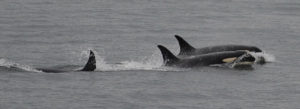A recently reported incident out of the Pacific Northwest has added to the notion that animals grieve their loved ones who have died like humans do.

Mother orca J35 carrying her baby who had died
Credit: npr.org
A Southern Resident orca caught nationwide attention for two weeks when she was spotted carrying her dead calf on July 24. The mother, named J35, is 20 years old and, according to the Center for Whale Research, carried her dead calf for at least 17 days and 1,000 miles.
J35 (also known as Tahlequah) had saved her newborn’s body from sinking, supporting it on her forehead and pushing it towards rough seas near San Juan Island. Researchers worried about her fatigue and eating habits after the baby’s death, particularly because of the matrilineal nature of orca groups. If J35 had died, her adult son and others would have been in danger as well. Despite their concern over J35’s well-being, the researchers never planned to intervene.
This is the longest period researchers have observed a mother killer whale “tending” to a baby whale who had died. According to USA Today, whale experts say they’ve seen orca mothers carry their deceased babies for up to a week. Many times, however, they are stillborn.
Jenny Atkinson, executive director of The Whale Museum on San Juan Island, thinks J35 may have mourned for longer than usual because the baby was actually born. She said that typically researchers see mother orcas care for stillborn babies for “a day or so.”
The calf died just 30 minutes after it was first seen by a whale watch operator. This is unfortunately a recurring theme among this group of orcas. Roughly 75 percent of newborns have not survived in the two decades since the Southern Resident orca population has been designated as endangered.

J35 is seen here recently after letting go of her newborn who had died
Credit: whaleresearch.com
Still, bonding with the infant for even that short time may have been enough to cause J35 to grieve longer than usual.
“[J35] carried [her baby] for 17 months before it was born,” Atkinson said. “And we know that it swam by her side…so there is a part of me that believes that the grief could be much deeper, because they had bonded.”
Dwindling Population
The death of the newborn calf was sad not only for its mother, but also for the Southern Resident orca population as a whole. The Center for Whale Research keeps tabs on every single Southern Resident.
One hundred percent of Southern Resident orca pregnancies have failed in the past three years. As of June 2018, the Southern Resident population totals only 76 individuals.
A fascinating story told by a resident of San Juan Island was recounted by the Center for Whale Research:
At sunset, a group of five to six females gathered at the mouth of the cove in a close, tight-knit circle, staying at the surface in a harmonious circular motion for nearly two hours. As the light dimmed, I was able to watch them continue what seemed to be a ritual or ceremony. They stayed directly centered in the moonbeam, even as it moved. The lighting was too dim to see if the baby was still being kept afloat. It was both sad and special to witness this behavior.
It’s touching to see that our companions in the animal kingdom experience grief like we do. J35 clearly cared for her infant, keeping its body with her for roughly two weeks.
Atkinson of The Whale Museum thinks that the global response to J35’s grieving period makes sense.
“Orcas…are charismatic megafauna,” she said. “You’re going to feel that pain of grief — particularly if you’ve gone through grief in your own life.”
If the Southern Resident orca population cannot find a way to produce healthy new offspring, of course their future is bleak. However, individuals have long life-spans, so we could see the survivors for quite a while.

 Southern Resident Orca Mother Mourned Newborn Who Had Died
Southern Resident Orca Mother Mourned Newborn Who Had Died


 “In Case You Don’t Live Forever” by Ben Platt
“In Case You Don’t Live Forever” by Ben Platt
 Our Monthly Tip: Make an “In Case of Death” File to Ease Loved One’s Grief
Our Monthly Tip: Make an “In Case of Death” File to Ease Loved One’s Grief















